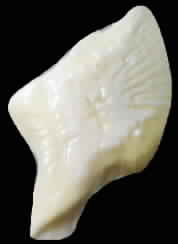This is one of those post which I try to take a relatively unknown concept and show how we would apply the principles of them to our height increase research. As I was watching the hugely popular show River Monsters last night, Jeremy wade started talking about how hard the outer skin or scales are of aligator gar. It seems that the aligator gar has a type of external layer of covering which makes it nearly impenetrable from the teeth and claws of other creatures. This type of scale like element is known as ganoid scales and ganoin. This ganoin material is supposed to be as hard as teeth enamel, and the properties of teeth enamel are that they have 3-5 times the strength as even our cortical bone. Teeth Enamel is very hard. The scales of these fish are just as hard. Native americans used the scales for hunting since the scales were that strong and tough.
Something that is known about sturgeons and gar are that they are very ancient creatures, which supposedly were around even when the dinosaurs were around. This means that as a species they are very tough and resilent, and somehow managed to survive whatever epidemic killed off the dinosaurs. I would guess that one of the reasons why the gar or sturgeon has been succesfull in terms of evolution is their scales, which makes them very hard to chew on. Injuries on gar and sturgeon would be very rare.
 However, the thing which is interesting is that the sturgeon like the gar can grow to immense sizes. There are reports from centuries back when European settlers first came that sturgeons could grow to be over 20 feet long and gar was growing up to 16 feet tall. These days those sizes don’t seem to be showing up. However, let’s just assume that the reportings of giant sized fish were true.
However, the thing which is interesting is that the sturgeon like the gar can grow to immense sizes. There are reports from centuries back when European settlers first came that sturgeons could grow to be over 20 feet long and gar was growing up to 16 feet tall. These days those sizes don’t seem to be showing up. However, let’s just assume that the reportings of giant sized fish were true.
Fish in general never stop growing, even in the adult stages. They have along with reptiles something known as indeterminate growth. Their growth is slower when they reached sexual maturity but their length continues.
If the species of gar and sturgeon can grow so much and so big, we must wonder how do they do it fi they are covered in such hard and rigid material like ganoin. How do the ganoid scales stretch out and accomodate the fish who is growing?
It seems that the key is that the scales are not connected together by the tough enamel like ganoin, but the boundary that scales intersect at is flexible. This area is where the gar can push and expand at.
From what I remember from my old days in fishing, most fish that I caught, which were sunfish had a vertebrate which I would call very flexible and cartilagenous. For sharks, they have no real “bones” like what mammals have. Their backbones are cartilage actually.
Implications For Height Increase
The ganoin that is on the top of the ganoid scales in these fish should have kept the fish from growing. They are as strong as human teeth enamel. Even the cartilage bones of the fish backbone would never be able to expand and hypertrophy enough to push the scales apart if the scales were really fused together at the intersecting boundaries. I am proposing that the reason fish like gar with such touch skin can grow is that their external surface covered in actual bone can stil expand because the hard bone is embedded with a pattern of none ganoin to push the whole fish out.
The cartilage does play the role of cartilage growth, but the bone would have stopped the fish from getting longer. The way for this type of fish, the gar, to grow so long is not just that they live as a very long life (which they do), and not just because they experience indeterminate growth (which most fish do), bu that the bones around their body is not completely enveloping them.
What I am proposing is that maybe at some point in the next few years, we find out what is the material that is between the scales of fish like gar. Is it collagen? cartilage? skin tissue?
This material does not go through the type of ossification process we see in humans. Why doesn’t it?
In human physiology theory, any area between two bone segments that are so close together would eventually experience vascularization, calcification, and eventual ossification. The gar with its bone body somehow has a way to prevent that tissue in the middle part to never ossify. That is what I want to study further.
